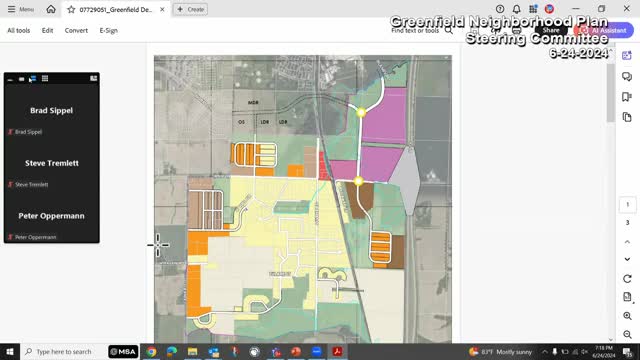Establishing urban growth boundaries sparks heated debate
June 24, 2024 | Fitchburg, Dane County, Wisconsin

This article was created by AI summarizing key points discussed. AI makes mistakes, so for full details and context, please refer to the video of the full meeting. Please report any errors so we can fix them. Report an error »

During a recent government meeting, officials engaged in a robust discussion regarding urban growth boundaries and future development plans for the Fish Brook area. The conversation highlighted differing opinions on how to manage density and infrastructure in relation to transportation corridors.
One key point raised was the necessity of establishing urban growth boundaries to control development and maintain rural areas. A committee member emphasized that these boundaries should dictate where higher densities are permitted, particularly along transportation routes, while advocating for lower densities further from these corridors. This approach aims to ensure that infrastructure, such as sewer systems, can adequately support new developments without overwhelming existing resources.
The discussion also touched on the potential for new road connections, specifically the proposed Blaney extension, which could facilitate access to commercial and residential areas. However, concerns were voiced about landowner resistance and the feasibility of such developments, particularly regarding the use of eminent domain for public projects.
Committee members expressed a desire for more comprehensive planning, suggesting that the current pace of decision-making may not adequately reflect community concerns or the complexities of long-term development. There was a consensus that further public engagement is necessary to address the anxieties of residents regarding the implications of increased density and infrastructure changes.
Additionally, the need for more commercial property was highlighted, with officials noting that the area lacks large parcels suitable for business development. This gap presents an opportunity for future growth, but it must be balanced with the community's desire for maintaining its character and managing density effectively.
As the meeting concluded, members acknowledged the evolving nature of the development plans and the importance of revisiting these discussions in the coming years to adapt to changing circumstances and community needs.
One key point raised was the necessity of establishing urban growth boundaries to control development and maintain rural areas. A committee member emphasized that these boundaries should dictate where higher densities are permitted, particularly along transportation routes, while advocating for lower densities further from these corridors. This approach aims to ensure that infrastructure, such as sewer systems, can adequately support new developments without overwhelming existing resources.
The discussion also touched on the potential for new road connections, specifically the proposed Blaney extension, which could facilitate access to commercial and residential areas. However, concerns were voiced about landowner resistance and the feasibility of such developments, particularly regarding the use of eminent domain for public projects.
Committee members expressed a desire for more comprehensive planning, suggesting that the current pace of decision-making may not adequately reflect community concerns or the complexities of long-term development. There was a consensus that further public engagement is necessary to address the anxieties of residents regarding the implications of increased density and infrastructure changes.
Additionally, the need for more commercial property was highlighted, with officials noting that the area lacks large parcels suitable for business development. This gap presents an opportunity for future growth, but it must be balanced with the community's desire for maintaining its character and managing density effectively.
As the meeting concluded, members acknowledged the evolving nature of the development plans and the importance of revisiting these discussions in the coming years to adapt to changing circumstances and community needs.
View full meeting
This article is based on a recent meeting—watch the full video and explore the complete transcript for deeper insights into the discussion.
View full meeting
